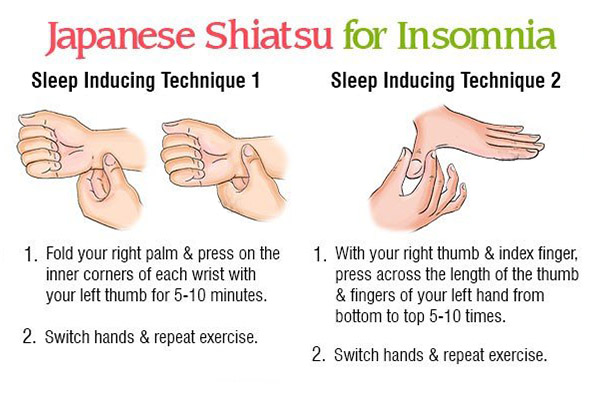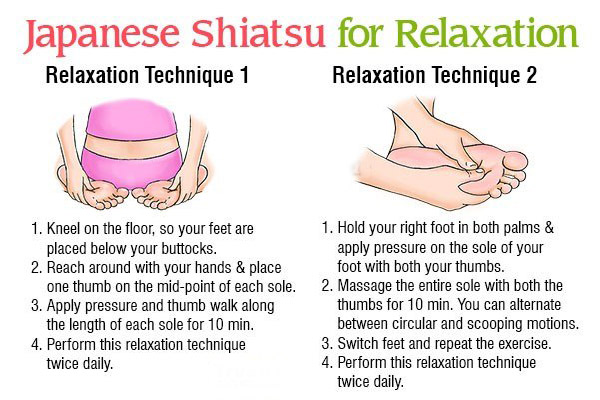In this article:
Bodywork is defined as any therapeutic or relaxing practice that involves the manual manipulation or regimented movement of body parts. This includes various forms of massage including self-massage techniques.

Doctors typically prescribe this alternative therapy as an adjunct to your main medical treatment or as part of your physical therapy regimen that is specifically designed for treating certain conditions.
Shiatsu is a century-old Japanese massage technique that involves stimulating specific points of the body by applying rhythmic topical pressure with your fingers. In fact, shiatsu translates to “finger press” in Japanese, but it also includes other medical therapies like acupuncture and anma massage within its purview. (1) Shiatsu itself falls under the category of bodywork.
Principles of Japanese Shiatsu
Shiatsu massage manipulates certain pressure points of the body to facilitate unhindered flow of energy or life force known as chi (or qi). (2)
Traditional Chinese medicine centers on the concept of chi, which is defined as the life force that runs through the body along specific pathways called meridians.
When this energy becomes blocked, disrupted, or deficient, you tend to develop symptoms of ill health that plague you frequently until the normal flow of chi is restored.
People with a chi imbalance usually suffer from cold and flu infections, fatigue, stress and anxiety, headaches, body aches, stiff and painful muscles and joints, gastrointestinal distress, and menstrual problems.
Shiatsu massage therapists can help relieve these problems by stimulating certain points along the meridians (called vital points) to promote the uninterrupted flow of chi throughout the body. Thus, shiatsu aims to restore the free and abundant movement of chi to ensure proper body function, maximum energy, and good mental and physical health.
Shiatsu bodywork typically involves breathing exercises and self-massage techniques.
Shiatsu for Pain Relief by Stimulating Blood Circulation

One of the many functions of blood is to deliver oxygen from the lungs to all tissues of the body.
When oxygen is impeded in some way from being properly delivered to an area of muscle, the resulting condition is known as ischemia. This localized oxygen shortage can cause the muscle tissue to become tight, painful, and unable to function properly.
Muscle fibers are shortened and thickened, making it even more difficult for local capillaries to deliver the needed oxygen, creating a cycle of oxygen deprivation, muscle tightening and pain, and muscle spasms.
Shiatsu can work in two ways to stimulate blood circulation and, thus, improve oxygen delivery:
- Pressure on the muscle tissue, whether applied by the fingers, palms, hands, etc., resets the shortened, thickened muscle fibers back to their proper length and thickness. This process allows for vessels in the area to open up so that oxygen- and nutrient-rich blood can flow through easily and waste by-products can be removed efficiently. Oxygen delivery to ischemic tissues facilitates recovery and repair in the affected area.
- Chi is once again receiving proper nourishment and is, therefore, able to move the blood along.
Best Shiatsu Sequence for Energy Flow
When practicing shiatsu, the primary energy system utilized is the system of meridians. Because meridians run over the body surface and also deep into the body, working the meridians from the surface has an effect on organ function. (3)
For example, a basic shiatsu sequence would begin by physically working the back and shoulders and then moving on to the buttocks, legs, feet, hips, abdomen, chest, arms and hands, neck, and finally head and face. (4)
In addition to working a basic shiatsu sequence, acupressure points known as tsubos can be stimulated while performing this basic sequence.
Tsubos are the sites through which the chi of the organs and meridians open to the surface of the body. There are specific areas of the body that correspond to specific points. (5)(6)
1. Shiatsu for energy flow
The following exercises can unblock the flow of chi from specific points so that it travels to the rest of the body and energizes your entire being.

Energy flow technique 1:
- Take your right foot in both palms.
- Place both your index fingers at the base of the big toe for a firm grip, and massage its top with both your thumbs in an upward direction.
- Perform this massage on each toe 5–10 times, and then do the same with the toes of the other feet.
This exercise promotes the upward flow of chi from your feet to the rest of your body.
Energy flow technique 2:
- Put both your hands on your chest, applying firm pressure.
- Massage your chest by moving it up and down for about 10 minutes.
This exercise stimulates the downward flow of chi from your chest to the rest of your body.
You can do both of these exercises twice a day, only one of them, or one exercise in the morning and the other at night in alternation.
2. Shiatsu for lower back pain
These shiatsu techniques can help relieve the pressure and pain from your lower back when done daily.
Technique 1:

- Lie down with your back and feet flat on the floor while your knees are bent upward.
- Place your hands by your sides and relax.
- Pull in a deep breath from your lower abdomen rather than your chest, and close your eyes.
- Lift your right knee toward your chest, hold it with both hands, and then release it slowly back to its initial position.
- Repeat the exercise with the other leg.
Technique 2:

- Hold your lower back with both your hands on either side such that the fingers lie on the top of your buttocks just where your back ends while your thumb points outward.
- Press your fingers into the starting spot for 5 seconds.
- Continue moving the fingers vertically up your back, pressing each point for 5 seconds.
- Perform this exercise 5–10 times.
You should perform both exercises at least once a day, but doing them twice will ensure better results.
3. Shiatsu for anxiety and stress
These easy-to-do shiatsu massages can instantly relax your mind and body to overcome stress and anxiety.
Anxiety reduction technique:

- Press your right thumb in the middle of your left palm for 30–60 seconds.
- Pull the fingers of your left hand with the opposite hand for 5 seconds each.
- Use your right thumb to vigorously stroke the entire left palm for 30–60 seconds.
- Massage the top of your wrist in circular motions for 30–60 seconds.
- Switch hands and repeat the exercise.
- Perform this exercise twice daily.
Stress reduction technique:

- Place your hands on your head with your fingers on your scalp and your thumbs against your temples.
- Gently press your thumbs into your temples and rotate them in circular motions while breathing deeply for 5–10 minutes.
- Perform this exercise twice daily.
4. Shiatsu for insomnia
These exercises can help you go to sleep faster and reduce nighttime awakening spells.
Deep, restful sleep is necessary for your body to repair and rejuvenate itself. A well-rested body is less prone to sickness.

Technique 1:
- Close your left hand to make a fist.
- Press your right thumb on the inner corner of your left wrist for 5–10 minutes.
- Switch hands and repeat.
Technique 2:
- Use your right thumb and index finger to individually press the thumb and fingers of your left hand, starting from the bottom up to the top.
- Do this 5–10 times on each finger/thumb.
- Switch hands and repeat.
5. Shiatsu for sinus pain
Sinus pain can be caused by several different disorders, each with its own treatment protocol.
For example, if sinus pain is specifically caused by sinusitis, then the points for stimulation are Lu7 of the lung meridian (metal), LI4 and LI20 of the large intestine meridian (metal), St3 of the stomach meridian (earth), SI18 of the small intestine meridian (fire), and St40.

- Put one index finger on each cheekbone and rotate it in circular motions while applying firm but gentle pressure for 5–10 minutes.
- Do the same on your forehead at the point where your eyebrows begin.
- Perform this exercise twice daily.
This kind of face massage promotes blood flow in your sinus cavity and thereby helps relieve the congestion.
6. Shiatsu for relaxation
Shiatsu massage calms your autonomic nervous system (ANS) to engender a deeply relaxing effect all over your body.
The ANS cannot be controlled through your conscious mind, and functions completely autonomously. It regulates involuntary processes like heart rate, breathing, blood pressure, and digestive and urinary processes.
The parasympathetic division of the autonomic nervous system is characterized by its primary job, which is to “rest and digest.” Shiatsu helps in the regulation of all organ functions involved in these autonomous physiological activities.

Relaxation technique 1:
- Kneel on the floor and tuck your feet under your buttocks.
- Press the midpoint of each sole with one thumb.
- Press your thumb on all the points forming a straight line along the length of each sole for 10 minutes.
Relaxation technique 2:
- Place your right foot in your palms and use both your thumbs to apply pressure to its sole.
- Give a 10-minute massage to your entire sole with both your thumbs, alternating between circular and scooping motions.
- Once you are done with the right foot, do the same with the other.
You can do both of these relaxation exercises twice, only one of them (depending on which provides greater relaxation), or one exercise in the morning and the other at night in alternation.
Medical Problems That Can Be Managed Through Shiatsu
The list of medical problems shiatsu can be used to treat is extensive, some of them include:
- Arthritis
- Diabetes
- Shoulder pain
- Asthma
- Edema
- Stroke
- Bell’s palsy
- Tinnitus due to high blood pressure
- Depression
- Muscle cramps
- Thyroid problems
- Digestive ailments
- Plantar fasciitis
- Tremors
Can Shiatsu Be Performed at Home?
Shiatsu can be performed at home and on oneself provided the points are accessible.
Points to Remember When Performing Shiatsu
It is important to remember that shiatsu is not recommended for all conditions. Shiatsu is not appropriate for the following cases:
- Neither the practitioner nor the patient should indulge in a heavy meal before shiatsu. The chi will be “focused” on digestion and will not be as effective around the rest of the body.
- It is contraindicated to perform shiatsu on broken bones, varicose veins, deep cuts, or other injuries.
- During pregnancy, shiatsu on the ankles, the fleshy area of the hand between the thumb and the base of the first finger, the top of the shoulders, and the abdomen should all be avoided. Working these areas can stimulate the womb and can be helpful during labor but is absolutely contraindicated during pregnancy.
- Shiatsu should be approached with a calm state of mind.
- Certain problems or conditions should be treated by an experienced practitioner and not by a beginner.
- Avoid performing shiatsu on patients with serious health problems such as cancer, multiple sclerosis, severe arthritis, and heart problems, unless you have been specifically trained to address the needs of such patients.
- If you feel uneasy, for any reason (or any unexplainable reason), about participating in a shiatsu session either as a practitioner or as a patient, you should always follow your intuition.
- Was this article helpful?
- YES, THANKS!NOT REALLY


